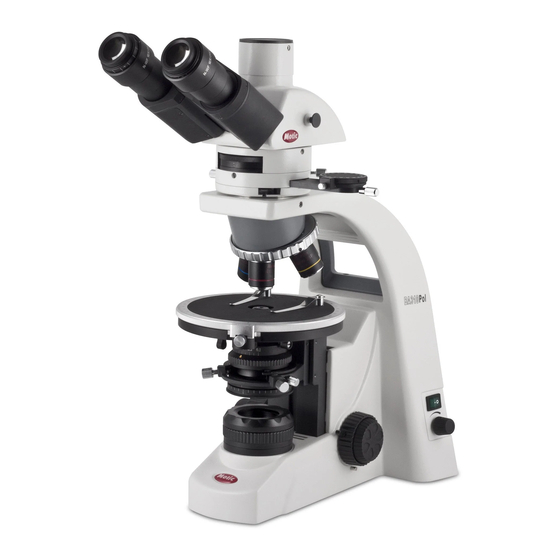
Table of Contents
Advertisement
Quick Links
Advertisement
Table of Contents

Summary of Contents for Motic 1100401200572
- Page 1 Instruction Manual English Motic Incorporation Ltd. UL Listed Product E250223...
- Page 2 We are constantly endeavouring to improve our instruments and to adapt them to the requirements of modern research techniques and testing methods. This involves modification to the mechanical structure and optical design of our instruments. Therefore, all descriptions and illustrations in this instruction manu- al, including all specifications are subject to change without notice.
- Page 3 INFINITY OPTICAL SYSTEM An optical configuration (in which the specimen is located at oblique angles, moving forward diagonally but still in parallel the front focal plane of the objective) gathers light transmitted bundles toward the tube lens. All of the light gathered by the through or reflected from the central portion of the specimen tube lens is then focused at the intermediate image plane, and and produces a parallel bundle of rays projected along the opti-...
-
Page 5: Table Of Contents
TABLE OF CONTENTS Page Section Nomenclature Setting Up The Instrument Assembling The Microscope Input Voltage Lamp And Lamp House Cover House (Replacing The Lamp) Lamp Mechanical Stage Specimen Holder Objectives Condenser Eyepiece Tube Eyepieces 3.10 Filters 3.11 Power Cord Microscopy, Manipulation Of Each Component Coarse and fine focusing Coarse focus torque adjustment Coarse focus Knob lock... -
Page 6: Nomenclature
1. Nomenclature Interpupillary distance scale Eyepiece Diopter adjustment ring Eyepiece lock screw Binocular eyepiece tube Objective Stage Condenser aperture ring Condenser focus knob Stage Y-Axis travel knob Fine focus knob Stage X-Axis travel knob Coarse focus knob Field lens Coarse focus torque adjustment ring Field diaphragm ring... - Page 7 Photo port Trinocular eyepiece tube Optical Path Changeover lever Eyepiece tube Clamp Screw Revolving nosepiece Specimen Holder Condenser Condenser aperture scale clamp screw Coarse focus height stopper Condenser Power switch centering screws Brightness control knob Power input Fine focus knob BA310 Trinocular...
-
Page 8: Setting Up The Instrument
2. Setting Up The Instrument 3. Assembling The Microscope 3.1. Input Voltage Avoid placing the instrument in locations exposed to direct sunlight, dust, vibration, high temperature, high humidity and where it is difficult to unplug the power supply cord. • The automatic voltage selection works with a broad range of settings. - Page 9 wipe it clean using lens tissue. 3. Disconnect the LED connection cables from the power sup- • Close lamp house cover plate and secure until it snaps into ply printed circuit board. position. b. LED 1. Unscrew two hexagonal screws retaining the base plate. 4.
-
Page 10: Lamp
3.3. Lamp the microscope arm. Tighten the eyepiece tube clamp screw to secure the eyepiece tube in place. a. Halogen Lamp 3.9. Eyepieces • The quartz halogen lamp, used as a light source, has higher luminance and color temperature than conventional tungsten lamps. -
Page 11: Power Cord
4. Microscopy 4.1. Coarse And Fine Focusing • Filter selection: • Focusing is carried out with the coarse and fine focus knobs Filter Function at the left and right of the microscope stand. ND2 (T=50%) For brightness adjustment in photomicrography •... -
Page 12: Interpupillary Distance Adjustment
4.5. Interpupillary Distance Adjustment 4.8. Use Of Aperture Diaphragm • Before adjusting the interpupillary distance, bring a specimen • The condenser aperture diaphragm is provided for adjusting into focus using the 10x objective. the numerical aperture (N.A.) of the illuminating system of the •... -
Page 13: Photomicrographic Procedure
• The immersion oil supplied by Motic is synthetic, non-fluo- the observation tube and phototube will be 0:100. rescing and non-resining oil, with a refractive index of 1.515 •... -
Page 14: Troubleshooting Table
7. Troubleshooting Table As you use your microscope, you may occasionally experience a problem. The troubleshooting table below contains the majority of fre- quently encountered problems and the possible causes. Optical Problem Possible Cause Vignetting or uneven brightness in the field of view or Lamp not installed properly field of view only partially visible Lamp not centred... - Page 15 Problem Possible Cause Insufficient parfocality of objectives Eyepiece diopter not adjusted No cohesion of binocular image Magnification or field of view of left and right eyepieces differ Interpupillary distance not adjusted Eyepiece diopter not adjusted Eye strain or fatigue Interpupillary distance not adjusted Diopter adjustment not made Field of view of left and right eyepiece differ Inadequate illumination...
-
Page 16: Care And Maintenance
Risk of burn – Do not touch the lamp during or immediately free service. after period of operation. • If repair become necessary, please contact your Motic agency Make sure the lamp has cooled sufficiently before attempting or our Technical Service direct. - Page 17 Canada | China | Germany | Spain | USA ® Motic Incorporation Ltd. (HONG KONG) * CCIS is a trademark of Motic Incorporation Ltd. Rm 2907-8, Windsor House, 311 Gloucester Road, Causeway Bay, Hong Kong Motic Incorporation Limited Copyright © 2002-2010.















Need help?
Do you have a question about the 1100401200572 and is the answer not in the manual?
Questions and answers